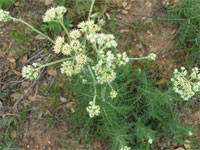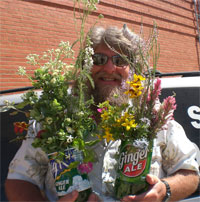Native Plant Road Trip – April, 2008

Wooly White, also known as Old Plainsman. Photo by the author.

Happiness is being Steven Chamblee at the Brownwood Garden Club’s Wildflower Festival. Photo by Pat Durraj.
Old Plainsman —
Brownwood Road Trip
I finally talked ole Neil into coming over and visiting Chandor Gardens. Thankfully, he brought his lovely wife, Lynn, so there was an air of class to the occasion. Otherwise, it would have likely been two grizzly plant guys debating the merits of sulfur, the cost/benefit ratio of pre-flighted ladybugs, and other such riveting topics. The garden looked great, with the fresh spring blooms of azaleas, spirea, and roses held high while the violas, snapdragons, and nemesia were at their peak, literally smothered in blossoms. It was a true pleasure to play host to someone who has had such a great impact on my life, and the lives of many others as well.
The next day, I took a few minutes to ponder the garden before heading down to Brownwood to give my “Texas Top Sixes” presentation. In a few weeks, the garden will pause for a few moments to breathe deeply, exhaling the leftover softness of spring before heartily inhaling the robustness of summer. Toby and I will strip the waning annual flower beds clean one day, and they will be replanted the next by a swarm of enthusiastic Parker County Master Gardeners, who come out twice a month to perform such magic … 120 flats of 4-inch pots planted in about two hours … it is a sight to see!
So I dropped down through Tin Top and Thorp Spring before settling in on 377 for the ride to Brownwood. The wonderful world of wildflowers created an ever-changing palette of color along the road — from the tender pink of Evening Primrose to the golden yellow of Engelmann Daisy to the rich, royal purple of Trailing Winecups. Even saw a Standing Winecup! But the coup de grace had to be the solid, 100-acre sheet of lavender created by Prairie Verbena. Since there were a few cows roaming that pasture, I had to surmise that a soft-hearted rancher overlooked a few dollars profit for the sake of public beauty. (Thank you!)
Among the other familiar wildflower friends, I spotted lots of Old Plainsman, also called Wooly White (Hymenopappus artemisiaefolius). It has small clusters of cream-colored blossoms held high atop gray stems above silvery, sharply incised leaves (like artemisia foliage, as the botanical name suggests). I have loved this plant for years, but somehow had never gotten truly close to it. Upon magnification, the pea-sized inflorescences become like frozen explosions, with five pure white petals, curled back from the force of the thrusting pistils. And the fragrance … possibly the sweetest flower I have ever encountered! I can only describe it as a close encounter with heaven … dipped in honey.
By the time I got to Brownwood, I had a bad case of wildflower fever, which made it hard to focus on my talk. You can tell bona fide plant people when your presentation goes way long and nobody leaves and you get lots of questions at the end. I got lots of support from my hosts, Jack and Gilda Sanford, who were heading up this sweet little event. Jack is a retired biology professor from Howard Payne University and author of Keys to the Vascular Plants of the Texas Edwards Plateau and Adjacent Areas. (The dude really knows his natives….) When I was about packed up to go, Jack asked me to stop in and check out the wildflower exhibit.
I’ve seen a lot of horticultural things in my time, some big, some small, but this knocked me out. Almost two hundred different fresh wildflower inflorescences from all around the Brownwood area! I’ve seen similar shows with commercially available garden plants, but this was all native stuff from roadsides, pastures, prairies, and woodlands. This is true Texas! Incredibly intricate spheres of Antelope Horns, delicate crinkles of Puccoon, the breezy fragrance of Texas Blue Star, impossibly delicate spikes of White Milkwort, tiny pale red striations inside the glowing golden cup of Yellow Flax, the tiny trumpets of Menodora, the ivory splash of Dewberry, the embossed star on Ground Cherry blossoms, the foot-long, purple-silver foxtails of Camassia, and pale orange, yellow, pink, magenta, rose, and red colors representing three different species of Indian Paintbrush. Does all of this sound familiar to you? No? Me, neither! I was humbled by my own inadequate knowledge of our state’s wildflowers … and I’m a plant guy.
Which brings me to you. I ask … plead … beg you to learn more about our natural heritage. Visit your local public garden, nature center, state park, and wildlife refuge. Check out the tons of information on the web; just enter "Texas Native Plants" and go from there. Hit the used bookstore for inexpensive field guides. And most of all, support and attend local events like plant sales, wildflower festivals, and nature study events such as hikes and plant rescues. Meet the folks who work so hard to preserve our natural heritage. Not for me, of course, but for yourself and future generations.
Peace & love,
Steven
P.S. As for my fire-scorched meadow in recovery … Indian Paintbrush, Milkvetch, Pink Evening Primrose, White Milkwort, Puccoon, Four-Nerve Daisy, Prairie Onion, Phlox, Little Bluestem, Pallid Yucca … and, oh yes, some other stuff I haven’t figured out yet!
About the author: Steven Chamblee is the chief horticulturist for Chandor Gardens in Weatherford and a regular contributor to Neil Sperry’s GARDENS magazine and e-gardens newsletter. Steven extends an invitation:
Come on out and see me at Chandor Gardens. Hours are 9 a.m. – 3 p.m. Saturday; 1 p.m. – 5 p.m. Sunday. For weekday tours or more information, call 817-613-1700 or go to our website, www.chandorgardens.com

